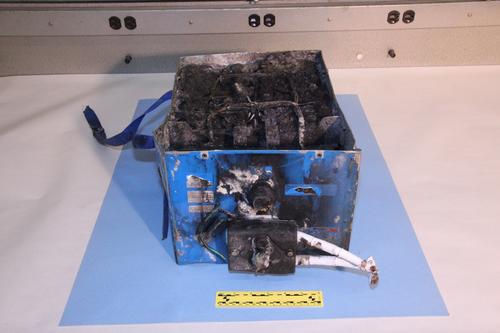
"Design News", 1/17/2013
Lithium-Ion Batteries Emerge as Possible Culprit in Dreamliner Incidents
Most of the concern around the 787 involves the use of lithium-ion batteries. The 787 is the first commercial aircraft to employ them. Its electrical architecture also operates at a higher voltages than predecessors, experts told us. "In terms of the ancillary systems, almost everything on the 787 is electrical,"
...the lithium-ion batteries are used for auxiliary power back-up. In the past... commercial airliners have typically used nickel-cadmium chemistries.
Automakers, many of whom use lithium-ion chemistries in hybrids and electric cars, typically operate their batteries with cooling systems. The Chevy Volt, for example, employs a fluid coolant that circulates through 1mm thick channels machined into 144 metal plates sitting between the battery's cells. Other automakers have employed air cooling on hybrids.
NYTimes, 1/18/2013 Powerful and lightweight, lithium-ion batteries are the perfect power source for modern gadgets. But ubiquitous as they are, their short history has also been fraught with problems — they have caught fire in cellphones, laptop computers and electric cars, and even destroyed a small Navy submarine.
A succession of problems has plagued Boeing's 787 Dreamliner, but investigators are now most concerned about incidents involving overheating of lithium-ion batteries.
Federal Aviation Administration (FAA) officials grounded Boeing's high-tech Dreamliner after battery electrolytes reportedly leaked from a lithium-ion battery onboard an All Nippon Airways flight on Wednesday. The liquid reportedly traveled through an electrical room floor to the outside of the aircraft, leaving burn marks around damaged areas.
The latest incident followed on the heels of two battery-related problems encountered on Japan Airlines flights and another on a United flight earlier this month. Those incidents happened in parallel with multiple other episodes, including two fuel leaks. Since July, the 787 has also encountered a damaged cockpit window, an oil leak, and two cracked engines, according to multiple news reports.
Aviation experts said most of the problems are unrelated. "I tend not to believe that there's a single root cause behind all of this," David Freiwald, an assistant professor of aerospace at Embry-Riddle Aeronautical University, told Design News. "Any new system has teething or growing pains. A few issues are to be expected."
The incidents did motivate aviation authorities around the world to order stoppage of Boeing 787 flights, however. The FAA also announced it will work with Boeing engineers to conduct a comprehensive review of the 787's design and manufacture, with an emphasis on the aircraft's electrical power and distribution systems.
On its website, Boeing emphasized the safety of its new aircraft, releasing a statement saying, "The airplane has logged 50,000 hours of flight and there are more than 150 flights occurring daily. Its service is on par with the industry's best-ever introduction into service -- the Boeing 777. Like the 777, at 15 months of service, we are seeing the 787's fleet wide dispatch reliability well above 90 percent."
Battery experts told Design News that the choice of a lithium-ion chemistry shouldn't be a problem, but it does call for tighter control. "Lithium-ion is a pretty energetic material," Eric Dietz, a professor of computer and information science at Purdue University, told us. "You've got oxidation and reduction reactions happening in close proximity to one another, so it's important to maintain engineering control around the battery."